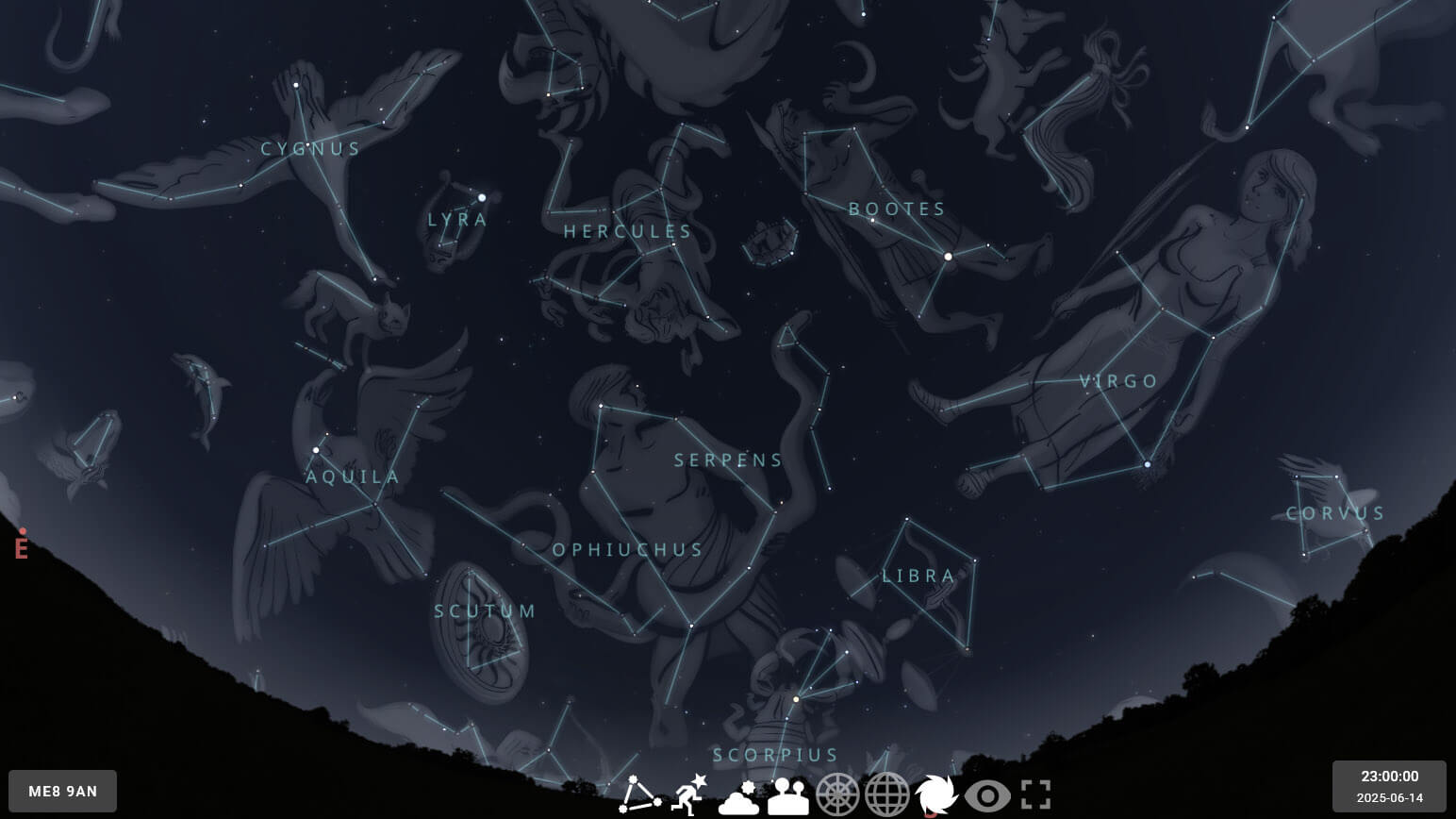TRAC Action Plan: July 2025
- Category: Action Plans
- Author: JM
- Published: 02 Jul 2025
- Last updated: 04 Jul 2025
July 2025 Calendar
- Wed, 02 Jul First Quarter Moon
- Thu, 03 Jul Earth at aphelion (furthest from the Sun)
- Thu, 03 Jul Moon close to Spica (Virgo)
- Mon, 07 Jul Moon close to Antares (Scorpius)
- Thu, 10 Jul Full Moon
- Fri, 18 Jul Last Quarter Moon
- Thu, 24 Jul New Moon
- Sun, 26 Jul Moon close to Regulus (Leo)
- Mon, 28 Jul Moon close to Mars
- Wed, 30 Jul Alpha Capricornids Meteor Shower peaks
Summer Stargazing
Summer Constellations
A clear night will give us a chance to spot the summer triangle and the main summer constellations:
- Lyra (Vega)
- Aquila (Altair)
- Cygnus (Deneb)
- Hercules (The Keystone)
- Libra
- Scorpius (Antares)
- Vulpecula
- Sagittarius

Image credit: Stellarium
Antares
The red supergiant star Antares (mag. +1.0) in Scorpius (The Scorpion) is on our list of main targets for 2025.
Check back to our June 2025 Action Plan for more information about Antares.
Alpha Capricornids Meteor Shower
This meteor shower will peak on 30 Jul 2025. Although this shower only produces around five meteors per hour (under ideal conditions), they can be quite bright and even fireballs are possible.
Solar Observations
Warning!
NEVER look directly at the Sun without using certified solar filters.
Incorrectly viewing the Sun can cause serious eye damage or permanent blindness. The following ways are NOT safe:
- The naked eye
- Sunglasses
- Binoculars
- Smoked glass
- Cameras
- Phones
Safe ways to view the Sun:
- ISO-certified eclipse glasses from a reputable manufacturer
- Special solar filters and solar film for telescopes/cameras
- Pinhole cameras and other projection devices/methods
Your eyesight is priceless. Do NOT take any risks.
NEVER allow children to view the Sun on their own.
Sunspots and Solar Photography
We still need some extra practice at photographing the Sun.
Sunny July afternoons are an excellent time to view the Sun from the UK.
Planets
It's unlikely that we'll see any planets this month unless we wake up very early before dawn.
Lunar Observations
July 2025 Lunar Calendar
- First Quarter Wed 02
- Full Moon Thu 10
- Last Quarter Fri 18
- New Moon Thu 24
Lunar Photography
Last year, we acquired a SVBONY SV105 Planetary Camera IMX307 which is designed for beginners in astrophotography. This time of year, with the warm evenings, is an ideal time for us to test it out. Let's see if we're able to view the Moon on a laptop screen by connecting the camera to the telescope.
July's Full Moon
The Full Moon in July will again be low in the sky like we saw in June as a result of the Major Lunar Standstill this year. Around the date of the Full Moon could be a good time to test the astro camera.
Moon Conjunctions & Occultations
Conjunctions involving the Moon and a planet or a bright star, though common, always provide good photo opportunities.
The conjunctions at the end of the month will be more challenging to spot due to the low altitude of the Moon after twilight at this time of the year.
| Date | Approx Time | Planet/Star | Moon Phase |
|---|---|---|---|
| Thu 03 Jul | After 22:30 | Spica (Virgo) | 61% Waxing Gibbous |
| Mon 07 Jun | After 22:30 | Antares (Scorpius) | 91% Waxing Gibbous |
| Sat 26 Jun | After 21:00 | Regulus (Leo) | 5% Waxing Crescent |
| Mon 28 Jun | After 21:30 | Mars | 17% Waxing Crescent |
Admin Tasks
Please refer to our June 2025 Action Plan.
Summary
Top Priorities for July 2025
In descending order of importance:
July Astrophotography
Photography opportunities this month include:
- Full Moon
- The Sun (Sunspots)
- Various Moon Conjunctions
See You Out There
July is always a quiet time for astronomy. The month will be a success if we manage to connect the astro camera to the telescope and produce some images of the Moon. This will be our first step towards getting some better photos of the Moon and solar system planets.
James M
TRAC Team Leader
02 Jul 2025 – Rainham, Kent

TRAC is an amateur astronomy group based in Rainham (Kent) in the United Kingdom.
On clear nights, you'll find us outside, observing stars, planets, moons, galaxies, satellites, meteors, and comets.
This action plan is specifically tailored for our location, schedules, optical equipment, level of experience, personal interests, and local sky conditions.
Unless stated otherwise, all magnitude values refer to apparent magnitude and have usually been rounded to one decimal place.
We welcome any questions, feedback, or suggestions you may have. Please let us know if anything is unclear or if you notice an error, inaccuracy, or typo. Contact us via email.
© 2025 Taverners Road Astronomy Club